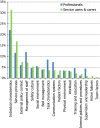A cross-sectional survey of mental health service users', carers' and professionals' priorities for patient safety in the United Kingdom
- PMID: 30120809
- PMCID: PMC6250880
- DOI: 10.1111/hex.12805
A cross-sectional survey of mental health service users', carers' and professionals' priorities for patient safety in the United Kingdom
Abstract
Background: Establishing patient safety priorities in psychiatry has received less international attention than in other areas of health care. This study aimed to identify safety issues as described by people in the United Kingdom identifying as mental health service users, carers and professionals.
Methods: A cross-sectional online survey was distributed via social media. Identified safety issues were mapped onto the Yorkshire Contributory Factors Framework (YCFF) which categorizes factors that contribute to patient safety incidents in general hospital settings. Service user and carer responses were described separately from professional responses using descriptive statistics.
Results: One hundred and eighty-five responses from 95 service users and carers and 90 professionals were analysed. Seventy different safety issues were identified. These were mapped onto the 17 existing categories of the YCFF and two additional categories created to form the YCFF-MH. Most frequently identified issues were as follows: "Individual characteristics" (of staff) which included competence and listening skills; "Service process" that contained concerns about waiting times; "Management of staff and staffing levels" dominated by staffing levels; and "External policy context" which included the overall resourcing of services. Professionals identified staffing levels and inadequate community provision more frequently than service users and carers, who in turn identified crisis care more frequently.
Conclusions: This study updates knowledge on stakeholder perceived safety issues across mental health care. It shows a far broader range of issues relating to safety than has previously been described. The YCFF was successfully modified to describe these issues and areas for further coproduced research are suggested.
Keywords: attitude of health personnel; caregivers; health services research; inpatients; mental health services; patient safety; surveys and questionnaires.
© 2018 The Authors. Health Expectations published by John Wiley & Sons Ltd.
Figures
Similar articles
-
Service user and carer involvement in mental health care safety: raising concerns and improving the safety of services.BMC Health Serv Res. 2018 Aug 17;18(1):644. doi: 10.1186/s12913-018-3455-5. BMC Health Serv Res. 2018. PMID: 30119632 Free PMC article.
-
A qualitative exploration of mental health service user and carer perspectives on safety issues in UK mental health services.Health Expect. 2020 Jun;23(3):549-561. doi: 10.1111/hex.13025. Epub 2020 Feb 11. Health Expect. 2020. PMID: 32045094 Free PMC article.
-
EQUIP training the trainers: an evaluation of a training programme for service users and carers involved in training mental health professionals in user-involved care planning.J Psychiatr Ment Health Nurs. 2017 Aug;24(6):367-376. doi: 10.1111/jpm.12361. Epub 2017 Jan 20. J Psychiatr Ment Health Nurs. 2017. PMID: 28105690
-
Mental health services, care provision, and professional support for people diagnosed with borderline personality disorder: systematic review of service-user, family, and carer perspectives.J Ment Health. 2021 Oct;30(5):619-633. doi: 10.1080/09638237.2019.1608923. Epub 2019 May 17. J Ment Health. 2021. PMID: 31099717
-
A qualitative meta-synthesis of service users' and carers' experiences of assessment and involuntary hospital admissions under mental health legislations: a five-year update.BMC Psychiatry. 2024 Jun 27;24(1):476. doi: 10.1186/s12888-024-05914-w. BMC Psychiatry. 2024. PMID: 38937705 Free PMC article.
Cited by
-
Identifying hot spots for harm and blind spots across the care pathway from patient complaints about general practice.Fam Pract. 2022 Jul 19;39(4):579-585. doi: 10.1093/fampra/cmab109. Fam Pract. 2022. PMID: 34537832 Free PMC article.
-
Patient safety incidents within adult community-based mental health services in England: A mixed-methods examination of reported incidents, contributory factors, and proposed solutions.Psychol Med. 2025 Feb 4;55:e8. doi: 10.1017/S0033291724003532. Psychol Med. 2025. PMID: 39901859 Free PMC article.
-
What does 'safe care' mean in the context of community-based mental health services? A qualitative exploration of the perspectives of service users, carers, and healthcare providers in England.BMC Health Serv Res. 2024 Sep 11;24(1):1053. doi: 10.1186/s12913-024-11473-3. BMC Health Serv Res. 2024. PMID: 39261858 Free PMC article.
-
Service user and carer involvement in mental health care safety: raising concerns and improving the safety of services.BMC Health Serv Res. 2018 Aug 17;18(1):644. doi: 10.1186/s12913-018-3455-5. BMC Health Serv Res. 2018. PMID: 30119632 Free PMC article.
-
A qualitative exploration of mental health service user and carer perspectives on safety issues in UK mental health services.Health Expect. 2020 Jun;23(3):549-561. doi: 10.1111/hex.13025. Epub 2020 Feb 11. Health Expect. 2020. PMID: 32045094 Free PMC article.
References
-
- Institute of Medicine . To Err is Human: Building a Safer Health System. Washington, DC: The National Academies Press; 2000. - PubMed
-
- World Health Organization . World Alliance for Patient Safety Progress Report 2006‐2007. 2008.
-
- Shekelle PG, Pronovost PJ, Wachter RM, et al. The top patient safety strategies that can be encouraged for adoption now. Ann Intern Med. 2013;158:365‐368. - PubMed
-
- Hernan AL, Giles SJ, Fuller J, Johnson JK, Walker C, Dunbar JA. Patient and carer identified factors which contribute to safety incidents in primary care: a qualitative study. BMJ Qual Saf. 2015;24:583‐593. - PubMed
Publication types
MeSH terms
LinkOut - more resources
Full Text Sources
Other Literature Sources
Medical


